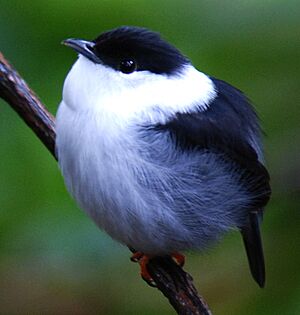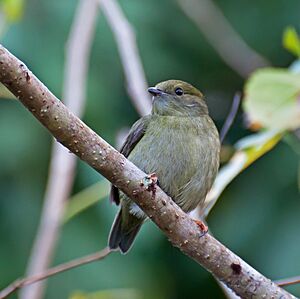White-bearded manakin facts for kids
Quick facts for kids White-bearded manakin |
|
|---|---|
 |
|
| Male | |
 |
|
| Female in São Paulo, Brazil | |
| Conservation status | |
| Scientific classification | |
| Genus: |
Manacus
|
| Species: |
manacus
|
 |
|
| Synonyms | |
|
Pipra manacus Linnaeus, 1766 |
|
The white-bearded manakin (Manacus manacus) is a small, colorful bird that lives in warm, tropical parts of South America. You can find it in countries like Colombia, Venezuela, Trinidad, and even further south in Bolivia and northern Argentina. These birds like to live in forests, areas where trees are growing back, and even on farms.
It's a small, round bird, usually about 10.7 centimetres (4.2 in) long. Male white-bearded manakins have a black head, back, wings, and tail, but the rest of their body is white. Females are mostly olive-green and look a bit like female golden-headed manakins. When it's time to find a mate, the males put on a special show on the forest floor, puffing out their neck feathers. This bird is quite common and lives in many places, so experts say it's not in danger of disappearing.
Contents
About the White-bearded Manakin
Like other manakins, the white-bearded manakin is a small, brightly colored forest bird. It's typically about 10.7 centimetres (4.2 in) long and weighs around 16.5 grams (0.58 oz).
The adult male has a black head, upper back, wings, and tail. The rest of his body is bright white. He also has orange legs.
Female manakins and young males are olive-green. They look similar to female golden-headed manakins, but they also have orange legs. The type of white-bearded manakin found only in Trinidad, called M. m. trinitatis, is a bit bigger than those on the mainland. Its females also have more yellow on their undersides. Besides a buzzing sound they make during their displays, these birds have other calls, like a musical peeerr sound.
What They Eat and How They Reproduce
White-bearded manakins mostly eat fruit. They also enjoy some insects and spiders.
Male white-bearded manakins have a very interesting way of attracting a mate. They gather in a special area called a lek. Each male clears a small patch of forest floor, making it bare earth. Then, he perches on a bare stick. His display involves quick jumps between sticks and the ground. As he jumps, he makes a loud wing snap, a whirring sound with his wings, and a chee-poo call. Sometimes, as many as 70 birds will perform together in one lek! The biggest leks are found in Trinidad.
The female builds a shallow, cup-shaped nest low in a tree. She lays two white eggs with brown spots. The female takes care of the eggs all by herself for about 18 to 19 days until they hatch. After hatching, the young birds stay in the nest for another 13 to 15 days. The mother feeds her babies mostly with fruit that she brings up from her stomach, along with some insects.
Where They Live
The white-bearded manakin lives across a very large area in South America. About two-thirds of its home range is in the Amazon Basin, the Guianas, and the area around the Orinoco River in Venezuela. You can also find them in eastern Colombia.
There are three separate groups of these birds that live in different places. One group is along the Pacific coast of Ecuador and southwestern Colombia. Another is in coastal and inland western Venezuela and northwestern Colombia. The largest group lives in southeastern Brazil, reaching into Paraguay in the south, and from the state of Paraná up to the coast of Pernambuco in the northeast.
Only one part of the Amazon Basin doesn't have this species: the 2,200 km area around the Purus River in southwestern Amazonas state.
Conservation Status
This bird has a very wide range, meaning it lives in many different places. It's also quite common, and scientists believe there are many white-bearded manakins in total. The number of these birds seems to be staying steady. Because of this, the International Union for Conservation of Nature has said that the bird's conservation status is of "least concern". This means it's not currently in danger.



